Wildlife Rehabilitation Centers: Visits That Matter
Wildlife Rehabilitation Centers play a crucial role in helping injured or orphaned animals. They offer these animals a second chance at life.
When you visit, you will discover the benefits of these centers. You will also learn about animal rehabilitation techniques and hear inspiring success stories.
Prepare for your visit thoughtfully. Explore how you can support and volunteer to make a meaningful impact on wildlife conservation.
Don’t miss your chance to see the incredible work these centers do!
Contents
- Key Takeaways:
- Why Visit a Wildlife Rehabilitation Center?
- How Wildlife Rehabilitation Centers Help Animals
- How to Prepare for a Visit to a Wildlife Rehabilitation Center
- Supporting and Volunteering at Wildlife Rehabilitation Centers
- Frequently Asked Questions
- What is a wildlife rehabilitation center?
- Why should I visit a wildlife rehabilitation center?
- Can I interact with the animals at a wildlife rehabilitation center?
- Are there any rules or regulations when visiting a wildlife rehabilitation center?
- What can I do to support a wildlife rehabilitation center?
- Can I bring in an injured or orphaned wild animal to a rehabilitation center?
Key Takeaways:

- Wildlife rehabilitation centers provide essential care for injured wildlife. Visiting allows you to learn about and contribute to their important work.
- At a wildlife center, you can see the positive impact these places have on animals. You’ll gain a deeper understanding of conservation and the protection of wildlife habitats.
- Volunteering at wildlife shelters is a great way to help animals in need. You can also contribute to protecting local ecosystems and wildlife.
What are Wildlife Rehabilitation Centers?
Wildlife Rehabilitation Centers are essential for caring for injured wildlife. They provide vital services to animals affected by accidents, habitat loss, or human actions.
These centers are staffed by trained professionals and volunteers. They focus on providing specialized care while educating the public about wildlife preservation.
Their goals extend beyond just individual animals. They help ensure healthy local wildlife populations, allowing species like birds, mammals, reptiles, and amphibians to thrive.
Each animal receives personalized care, including medical treatment, nutrition, and training to prepare them for life in the wild.
These centers often work with local communities to raise awareness. Their educational programs and volunteer opportunities change how we interact with wildlife.
This approach not only helps wildlife recover but also strengthens communities and enhances conservation efforts.
Why Visit a Wildlife Rehabilitation Center?
Visiting a Wildlife Rehabilitation Center offers you a chance to explore wildlife conservation. You ll witness the dedicated efforts to rehabilitate injured animals and care for diverse species.
These centers serve as important places for learning about wildlife. They highlight the challenges species face in our changing world.
By engaging with the knowledgeable staff and observing wildlife care, you enrich your understanding. You also help build public support for essential wildlife initiatives.
Benefits of Visiting
Visiting a Wildlife Rehabilitation Center enriches your life. It deepens your understanding of wildlife conservation and its crucial role in local ecosystems.
By engaging with these resources, you support efforts to preserve native habitats. You also learn about the challenges faced by wildlife species.
This experience heightens your awareness and instills a sense of responsibility for the welfare and health of wildlife.
Participate in educational programs and hands-on activities. Discover the urgent wildlife issues affecting your community. These interactions ignite meaningful discussions about sustainable practices and advocate for policies that protect vulnerable species.
Opportunities for community engagement, whether through volunteering or donations, enable you to adopt a collaborative approach to wildlife rehabilitation. When you take informed action, you directly support ongoing projects focused on rescuing, rehabilitating, and releasing injured animals back into their natural habitats.
This active involvement amplifies not just your personal commitment but also creates a ripple effect, inspiring others to care deeply about wildlife welfare. Join us in making a difference today!
How Wildlife Rehabilitation Centers Help Animals

Wildlife Rehabilitation Centers play a vital role in caring for injured animals. They provide specialized rehabilitation techniques and immediate emergency responses.
From triaging injured birds to nurturing orphaned mammals, these centers tailor methods to meet each species’ needs. A devoted team of volunteers and professionals works tirelessly to restore health and prepare animals for their return to the wild.
Rehabilitation Techniques and Success Stories
Wildlife Rehabilitation Centers use diverse techniques tailored to each animal’s health needs. Treatments include medical care, behavioral conditioning, and nutritional support.
Success stories highlight the resilience of injured animals and the dedication of teams ready to return them to natural habitats.
Consider the journey of a juvenile bald eagle treated for severe wing fractures. Skilled specialists used advanced rehabilitation techniques, allowing this eagle to regain strength through flight cage training that mimicked its natural environment.
Once deemed fit, the eagle was successfully released into a nearby national park, demonstrating the profound impact of these rehabilitation efforts on wildlife populations.
These initiatives do more than assist individual animals; they help ecosystems thrive and promote biodiversity, the variety of life in a place. Each success story highlights the vital intersection between human intervention and wildlife resilience, crafting a compelling narrative of hope and recovery.
How to Prepare for a Visit to a Wildlife Rehabilitation Center
Preparing for your visit to a Wildlife Rehabilitation Center requires a bit of insight into what awaits you and how to enhance your experience. As you engage with the wildlife resources and educational opportunities, remember that these centers serve as sanctuaries for injured animals.
The primary focus here is animal care, which may limit your ability to interact directly with the wildlife patients. However, don t let that deter you. The educational programs and guided tours offer invaluable insights into the intricate processes of wildlife care and recovery, as well as the critical importance of conservation efforts.
Embrace the opportunity to learn and appreciate the vital role these centers play in protecting our wildlife. They use wildlife permits, which are legal permissions needed to protect wildlife, to ensure safety.
What to Expect and What to Bring
When you visit a Wildlife Rehabilitation Center, prepare yourself for engaging wildlife encounters through educational programs that shine a light on the care and recovery of injured animals. Be sure to bring along a camera to capture those unforgettable moments and wear comfortable shoes for strolling about.
Most importantly, bring your curiosity to learn about wildlife care and conservation. You ll want to ask questions and dive into discussions to truly grasp the intricacies of wildlife rehabilitation and the challenges facing various wildlife species.
You ll discover exciting programs that let you dive into the world of wildlife care! These centers typically offer a rich array of programs, including guided tours, hands-on volunteer opportunities, and workshops that focus on specific species or conservation techniques. During your tour, remember to respect the animals’ space and adhere to any guidelines provided by the staff, ensuring both your safety and the comfort of the animals.
The experience can be profoundly moving, often leaving you with a heightened appreciation for nature and a renewed sense of responsibility toward preserving wildlife habitats. Engaging with knowledgeable staff and witnessing the care given to the animals fosters a strong connection, making these visits incredibly impactful.
Supporting and Volunteering at Wildlife Rehabilitation Centers

Supporting and volunteering at Wildlife Rehabilitation Centers offers a fulfilling opportunity to aid injured wildlife while immersing yourself in the intricacies of wildlife care and conservation efforts.
These centers often depend significantly on the dedication of volunteers like you, who assist with a range of vital tasks, from animal care to educational outreach, fundraising initiatives, and wildlife education. By engaging with the local community to promote wildlife initiatives, you cultivate a profound connection between people and the natural world, underscoring the critical importance of wildlife preservation.
Ways to Get Involved and Make a Difference
You have countless opportunities to get involved and make a significant impact at Wildlife Rehabilitation Centers. Whether you choose to volunteer your time or support fundraising events, your efforts play an essential role in sustaining wildlife care initiatives.
Volunteering often includes engaging, hands-on tasks like cleaning enclosures, feeding animals, and aiding in medical treatments each of which is vital to the rehabilitation process. You can also participate in events such as wildlife rescue fundraisers, educational workshops, and community clean-up days, offering additional ways to connect with your local centers.
By donating supplies or financial resources, you enhance the facilities capabilities, enabling them to rescue and rehabilitate even more wildlife patients. Don’t wait! Get involved today and be part of something powerful! Each contribution you make not only elevates the quality of care that wildlife receives but also promotes community education about ecological balance and the importance of protecting native species.
Frequently Asked Questions
What is a wildlife rehabilitation center?
These centers often provide a wildlife helpline for emergencies. A wildlife rehabilitation center is a facility dedicated to providing care for injured, orphaned, or sick wild animals, with the goal of releasing them back into their natural habitats.
Why should I visit a wildlife rehabilitation center?

Experience the amazing work that goes into helping wild animals! Learn how you can play a part in wildlife conservation and responsible interactions.
Can I interact with the animals at a wildlife rehabilitation center?
These animals are not pets. Interacting with them can cause stress and hinder their rehabilitation.
Are there any rules or regulations when visiting a wildlife rehabilitation center?
Most centers have strict rules to ensure the safety of both animals and visitors. These rules may include restrictions on touching or feeding animals and guidelines for behavior.
What can I do to support a wildlife rehabilitation center?
Your support is vital! Volunteer, donate, or simply spread the word about their important work in wildlife conservation.
Can I bring in an injured or orphaned wild animal to a rehabilitation center?
Yes, if you come across an injured or orphaned wild animal, you can bring them to a rehabilitation center for proper care. It is important to follow the center’s guidelines and contact them beforehand to ensure they have the resources and capacity to take in the animal.






